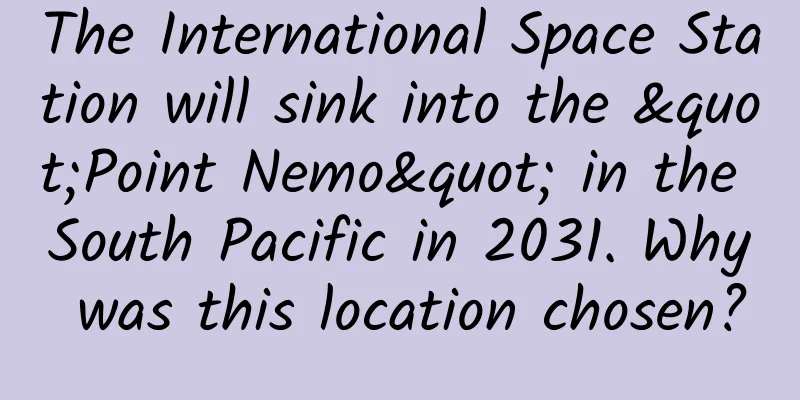The International Space Station will sink into the "Point Nemo" in the South Pacific in 2031. Why was this location chosen?

|
Do you know what is the largest and most complex aerospace project in the world? That's the International Space Station. The International Space Station was built in the early 1990s. It has a mass of about 500 tons and a volume equivalent to a five-story building. It took 7 different launchers, 136 flights and more than 1,000 hours of space work to assemble it. The construction cost was as high as 100 billion US dollars. Over the past 20 years, the International Space Station has continued to expand in size to attract astronauts from more countries to stay here, making outstanding contributions to the world's space industry. However, this expensive and important international space station is not meant to stay in space forever. Its retirement date has now been determined! NASA announced that it plans to destroy the International Space Station in 2031, and the wreckage will sink to Point Nemo in the South Pacific. The destruction process is expected to cost $1 billion. International Space Station Why destroy the International Space Station? The International Space Station is a complex space science laboratory. Its structure is very complex, including laboratory modules, living modules, energy supply modules, docking ports, scientific experimental equipment, etc. In the past 10 years, the International Space Station has provided an important experimental site for drug discovery, vaccine development and medical treatment, and has made outstanding contributions to real-time monitoring of the Earth's ecosystem and natural disasters. It can be said that the International Space Station is of great significance to the development of human society and related scientific research and technology. International Space Station Material Experiment Box However, after more than 20 years of operation, the International Space Station is facing the problem of aging infrastructure and components. The International Space Station has long been subjected to extreme temperatures during its orbital operation, which causes cyclic expansion and contraction of materials, thus causing wear and tear on the materials themselves. Over the past few years, the International Space Station has frequently experienced rollovers and air leaks, so astronauts have had to be sent to the International Space Station for repairs. Astronauts repair the International Space Station In addition, the International Space Station is located in the fragile upper region of the Earth's atmosphere, in low Earth orbit. Without periodic boosts, it will continue to move slower and slower, and its altitude will become lower and lower, eventually falling deep enough to disintegrate through the atmosphere and burn up. However, during the fall of the International Space Station, two things could happen. One is to fall into the atmosphere under precise control; the other is to deorbit under uncontrollable circumstances, causing the International Space Station to fall from high altitude to the surface of the earth. The second situation is particularly dangerous. Because the International Space Station is larger than a football field, its orbit covers more than 90% of the world's population. As the largest deorbited object in history, the fall of the International Space Station is likely to cause devastating damage to humans on Earth. "It will not be a good day." said George Naird, president of Commercial Space Technology. NASA spent $1 billion to destroy the International Space Station to avoid the second situation. The International Space Station's Fall NASA chose "Point Nemo" as the landing site for the International Space Station. Where is Point Nemo? Point Nemo is located deep in the South Pacific Ocean and was once widely known as the Spacecraft Graveyard. This area was the final resting place of the Mir space station. According to Wikipedia, more than 263 spacecraft rested here from 1971 to 2016. Point Nemo Location In order for the International Space Station to land accurately at Point Nemo, the first factor NASA must consider is the 11-year activity cycle of the sun. 11 years is an estimate, and the duration of the solar cycle can be longer or shorter, and the peak activity of each cycle also varies irregularly. High levels of solar activity cause the Earth's atmosphere to expand, which increases the drag on orbiting spacecraft. This drag causes altitude loss. "The process of deorbiting an object as large as the International Space Station is very dependent on atmospheric density conditions," explained David Anas, an aerospace engineer at Purdue University in the United States. "Even if you spend a lot of time, it's basically unpredictable." Combining all of the above factors, the ideal fall process would be like this: First, after weeks or months of natural orbital separation, the height of the International Space Station slowly decreases to an altitude of about 402 kilometers from the Earth. At this time, the custom-made vehicle connected to the space station will begin the deorbit burn. At an altitude of about 201 kilometers above the Earth's surface, the mission control team will adjust the trajectory of the International Space Station and the rocket burn to change the space station's nearly circular orbit into an elliptical shape, making it closest to the "perigee" about 145 kilometers above the Earth. From its perigee of 145 kilometers, mission control will command the rocket to perform a final burn, pushing the station further down toward the South Pacific. International Space Station Decommissioning Plan It is worth mentioning that no matter when and how the International Space Station falls to Earth, this event will be a major milestone in human aerospace. At that time, we will all witness the completion of this "feat" together. |
<<: 3 million images, 15,000 zebrafish embryos, scientists achieve AI embryo recognition
>>: He was the "last man who knew everything" and died at the age of 55
Recommend
Can viruses be used to treat diseases? Phage therapy - defeating magic with magic!
Author: Zhao Bei In our impression, viruses are o...
What can be done when evolution meets algorithms?
Everyone knows about the evolution of plants and ...
How can we get a reliable cancer screening that can cost thousands of dollars?
At the end of each year, many institutions organi...
6 major features of short video marketing promotion!
Why is short video marketing so popular? What are...
How can I tell the authenticity of the wine I bought for my dad?
Image source: Tuchong Creative How can I tell the...
Marketing promotion: How to improve promotion effectiveness by outputting excellent creative ideas?
With the upgrading of consumption, Chinese people...
What is the difference between a 5-cent egg and a 5-dollar egg? The answer is...
Everyone knows that eggs are rich in nutritional ...
OPPO R11s review: Your girlfriend's favorite phone is now even better
When it comes to domestic mobile phone brands wit...
Hortonworks Ted Yu: Tiny LFU, a highly efficient cache admission policy
[Original article from 51CTO.com] On November 25,...
Cloudrive 3.0, an integrated dual-map navigation system, is first installed on Tiggo 5x, opening up a new way of intelligent human-vehicle life
What will the future of car life look like? With ...
Gansu Province's TCM Prevention and Treatment Plan for Pneumonia Infected by the New Coronavirus (Trial)
This disease belongs to the category of "epi...
Do you run to escape reality? Beware of developing "exercise addiction"
Written by: Nan An The New Year has passed, and t...
Please check! This is the digital annual report from 2021
Producer/ Ke Rongyi Xing Zhigang Coordinator/ He ...
How to promote products with the help of KOLs on Xiaohongshu?
With the rise of awareness among the new generati...
How to operate a community from 0 to 1? Here are my 7 thoughts
Next, I will talk about building a community from...









